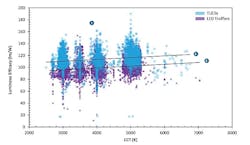DOE publishes Snapshot report on LED-based fluorescent replacement tubes
The US Department of Energy has released a new Caliper Snapshot report on linear LED-based tubes intended as fluorescent replacements and such lamps now represent the majority of all lamps listed in the Lighting Facts database.
The US Department of Energy (DOE) has released a Caliper Snapshot report entitled "Snapshot Linear Lamps (TLEDs)" that includes the latest findings by the agency on LED-based tubes intended as linear fluorescent replacement lamps. The report states that such TLED or LED T8 products represent 52% of all lamps that comprise the DOE's Lighting Facts database. Moreover, the linear solid-state lighting (SSL) products have the highest mean efficacy of any LED lamp product in the database with TLEDs added to the database in 2016 offering an average efficacy of 101 lm/W.
Interested in articles & announcements on LED tubes?
The DOE last reported on LED T8 products back in 2014 when it released a full Caliper report on the products. Caliper reports involve the agency purchasing representative products on the commercial market and then testing the photometric and electrical performance of those products. In 2014 there were only a few LED tubes tested that exceeded 90-lm/W efficacy. In the latest Snapshot report, one lamp exhibited efficacy of 190 lm/W.
The DOE report, however, is quick to make the point that TLED efficacy trails LED-based integrated fixtures significantly. The report reminds that the optical efficiency of linear troffer fixtures into which TLED lamps are installed is typically in the 75% to 85% range and that fact alone puts the LED lamps at a disadvantage relative to integral luminaires.
Still, the LED tubes are incredibly popular products due to the sheer volume of fluorescent troffer fixtures installed in North America and around the globe. Indeed, the DOE said there are more than 4500 TLED lamps in the Lighting Facts database and that represents more than 10% of the total entries including integral luminaire products.
The products in the Lighting Facts database come in three flavors — UL has classified them as Type A, B, and C. Type A products work with the existing fluorescent ballast although many such products only work with electronic instant-start ballasts. Type B products have an integral driver and those lamps need the fluorescent ballast to be removed from the system. And Type C products have an external driver that is installed in place of the fluorescent ballast. We published a feature article on the lamps last year with more details on lamp architecture. We also published an article in 2014 that contemplated the benefits of LED tubes that work with an existing ballast relative to those that require the ballast to be bypassed.
The latest DOE research shows that the TLED products are improving in every dimension. Indeed, efficacy only drops on average by 3 lm/W for every 1000K decrease in CCT. In the case of other LED-based lamps the efficacy penalty of warmer CCTs is far greater. And as the nearby figure demonstrates, there are many TLEDs on the market at warm CCTs and the products hold an efficacy advantage over fluorescent tubes with the typical LED product drawing 60% of the power of fluorescent tubes.
The LED tubes also generally exceed fluorescent lamps in terms of color quality. Typical products have CRI in the 80 range. Power factor is generally above 0.90. That said, integral LED-based luminaires still offer more energy savings and even better photometric performance, albeit at a higher purchase price and more expensive installation scenario.
You can peruse the full Snapshot report on the DOE SSL website.

Maury Wright | Editor in Chief
Maury Wright is an electronics engineer turned technology journalist, who has focused specifically on the LED & Lighting industry for the past decade. Wright first wrote for LEDs Magazine as a contractor in 2010, and took over as Editor-in-Chief in 2012. He has broad experience in technology areas ranging from microprocessors to digital media to wireless networks that he gained over 30 years in the trade press. Wright has experience running global editorial operations, such as during his tenure as worldwide editorial director of EDN Magazine, and has been instrumental in launching publication websites going back to the earliest days of the Internet. Wright has won numerous industry awards, including multiple ASBPE national awards for B2B journalism excellence, and has received finalist recognition for LEDs Magazine in the FOLIO Eddie Awards. He received a BS in electrical engineering from Auburn University.





